|
Örjan Martinsson
| |
|

The Norwegian army trace its lineage from 1628 when five national regiments
were raised by conscription. The number of regiments varied during the 17th
century but at the start of the Great Northern War there were six national
regiments recruited from the following stiftamt (counties):
In
addition to the national regiments, there were until 1701 two and then one
enlisted regiment. More were added after the outbreak
of war in 1709. The cavalry,
which from 1701 consisted exclusively of dragoons, was also mainly national
(that is, raised by conscription), but there were also enlisted companies
within the regiments.
During the 17th century there
were much variation of uniform colours, but in the beginning of the 18th
century the Norwegian army had just like the Danes adopted mainly light grey coats with facings and
lining in a distinctive regimental colour. The cut on the uniforms were also
the same as for the Danish army. Although it took longer for changes to be
adopted in Norway since the national regiments only received new coats every
tenth year during peace time. The double-breasted coat, which was
characteristic for the 18th century Danish army, began to be
introduced possible only from 1706.
Red coats also occurred and
became more common in the 1710s. On 24 December 1717 it was decided that all regiments
should have red coats. It was also at the same time decided that all
national regiments were to be split in two. The only exception was Trondhjemske
which had been split already in 1710 and from which a third regiment was to
be created. However, the threat of a Swedish invasion postponed the
implementation of the reorganisation and new uniforms until the end of 1718,
in September for Akershusiske, Smaalenske and Oplandske regiments,
in November for Vesterlenske Regiment and in December for Bergenhusiske
Regiment. The third Trondhjemske regiment was not created until January 1719.
|
|
The Enlisted Regiment
(Det geworbene regiment) |
|
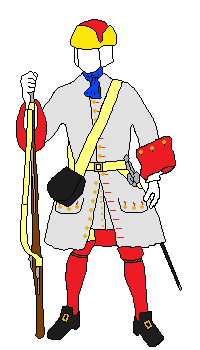
1688 |
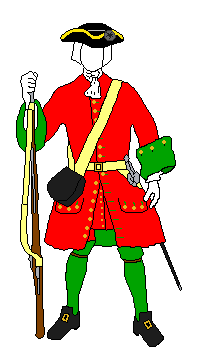
1702 |
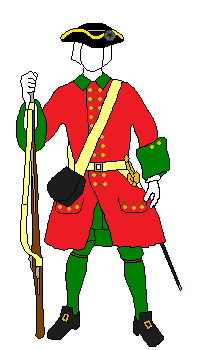
1712-1718 |
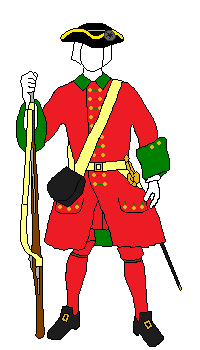
m/1717 |
|
Krag’s
regiment: Light grey coat with red cuffs and
lining, and blue neckcloths.
When Krag's
regiment was raised in 1687, it had first received red karpuses with
yellow facings and coats with varying colours. |
The merged
regiment now received cassocks, coats and breeches of red cloth with
green lining and brass buttons.
This uniform
had been intended for the Gyldenløwe’s regiment and the colours are said
to have been slightly lighter than what had been commissioned. |
The same
colours as in 1702 but now the vest and leg clothes are
reported to have been green. The uniform was issued in 1711/1712
and replaced one that had been issued on 24 April 1710. The cassock
(cloak) was now replaced by a surtout (coat) which after 1½ years was to
be re-sewn into a camisole (vest with sleeves) and replaced with a new
surtout tank.
Höglund states
that the coat was red with a green collar in 1714. |
A regulation
in 1717 prescribed that the coat, breeches and stockings were to be red
and that the cuffs and lining were to be green. Yellow buttons. Schorr
states that the regiments that participated in the North German
campaigns of 1713-1716 acquired red leg clothes.
However, the
leg clothes were green in 1727 and dark green in 1730. The lining and
cuffs on the coat were light green in 1727 and dark green in 1730. |
In 1687 and 1688 two enlisted regiments were raised, first under the
command of Krag and Boynenbourg and later under Hausmann and Gyldenløwe. The
regiments were merged in 1701 under Hausmann's command. In 1704 Hausmann was
succeeded by Cicignon who commanded the regiment for the rest of the Great
Northern War.
The regiment was transferred in 1712 to Jutland and participated in the
siege of Tönning and the Pomeranian campaigns of 1715-16 (including the
Battle of Stresow). Back in Norway, it participated in the campaigns in 1716
and 1718 and in the attack on Bohuslän in 1719. |
|
Akershusiske
Regiment
|
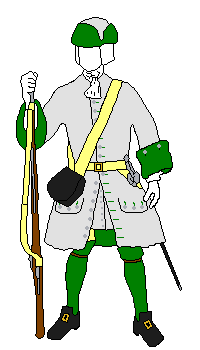
1670 |
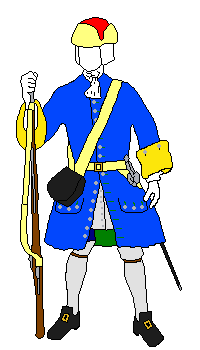
1676? |
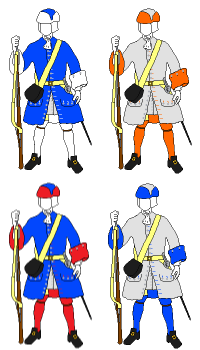
1683-1695 |
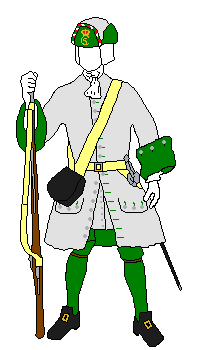
1698-1710 |
|
Light grey coat with green trimming. |
An unreliable source states blue coat with yellow
facings, green trimming and white buttons. as well as dark blue
breeches, grey stockings, ankle shoes and a leather cap with a red
top. |
1683 Grey coat
1685 Blue coat with red (or possibly white) lining.
1688
Light grey coat with facings and lining in aurora.
1694 Blue coat with red lining.
1695 Uniform changed to grey coat with blue lining |
New
uniforms were issued in 1698 and 1700. According to an regulation
from 1697, they were to consist of grey coats with green lining,
breeches, stockings and caps. The buttons should be white.
In 1702
the uniform is described as a white coat with green lining, breeches
and stockings. White karpus with green flaps, the front bordered
with red-green-white lace and decorated with Christian V's monogram.
The grenadiers also had a fringe of bear fur along the striped lace
and the coat of arms of Norway instead of Christian V's monogram. |
|
Referred to in 1646 as the "blue regiment". In 1648, the
colonel received uniforms for 3-400 men who were to be mustered.
Blue uniforms on 2 July and 141 red coats on 28 July. Many soldiers
had "round caps like nightcaps" and at the same time there
were 290 grey hats.
In 1658 the regiment had coats of grey cloth. |
|
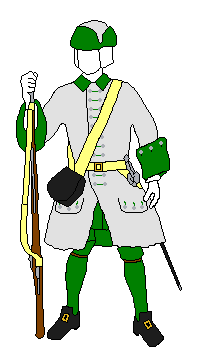
1710-1718 |
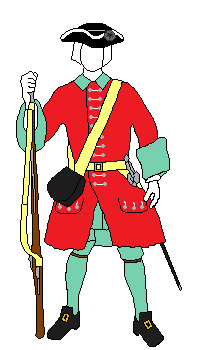
m/1717 |
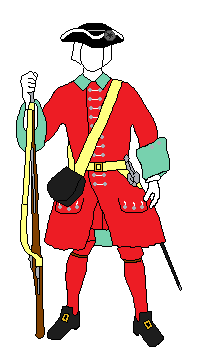
1718-1727 |
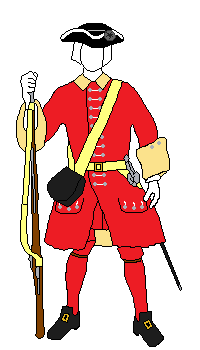
2nd Akershusiske 1727 |
|
New uniforms were issued in 1710 which in 1713 were
described as white coat with green cuffs, lining, breeches and
stockings. This should have been the first uniform with double rows
of buttons on the coat. Six companies in Trøndelag still wore this
uniform during the 1718 campaign. |
According to the 1717 regulation, the uniform was to
consist of a red coat with celadon (sea green) cuffs, lining,
breeches and stockings, and white buttons and buttonholes. |
In September 1718, the m/1717 uniform was issued. According to Schorr,
breeches, stockings and buttonholes may have been red
instead of celadon. Skjold Petersen specifies red breeches and
stockings, but white buttonholes. The vest he states is celadon for
First Akershusiske but red for Second Akershusiske. |
During the following
10-year period after the partition of the regiment in 1718, Second
Akershusiske received new uniforms with paille as the regimental colour.
Skjold Petersen gives the year 1727 for this. If they did not
already have it in 1718, both regiments were issued red breeches and
stockings. |
Akershusiske regiment was formed in 1641 and was
split in 1718 into First Akershusiske (western half) and Second
Akershusiske (eastern half). Until 1718, the regiment had also been armed
with plug bayonets instead of socket bayonets.
Höglund deviates from both Aagaard and Schorr by
specifying separate uniforms for the regiments as early as 1718 and 1720
(which, moreover, do not agree with each other or the later uniforms
mentioned by Aagaard). According to him, First Akershusiske had celadon
green cuffs with black edge in 1718 and green collar in 1720. Second
Akershusiske is said to have had light green cuffs with yellow edge in 1718
and white collar with red edge in 1720. He also describes celadon as an
olive-green shade.
|
|
Smaalenske
Regiment
|
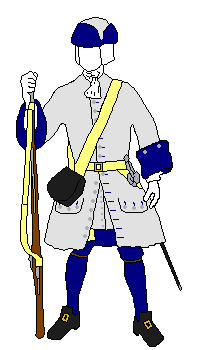
1670 |
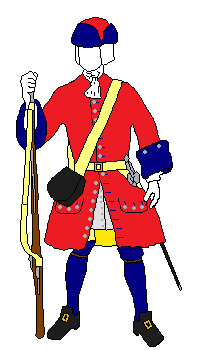
1680 |
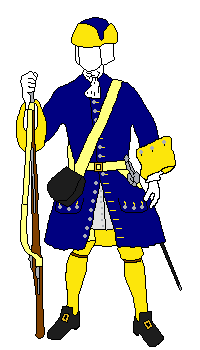
1685? |
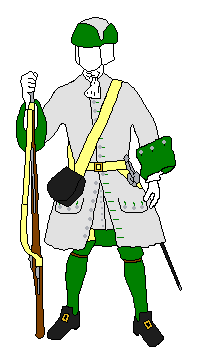
1695 |
|
Light grey
coat with blue lining and cuffs. |
Red coat
with blue cuffs and yellow lining. |
According
to Aagaard, they either had a blue coat with yellow lining or a grey
coat with blue lining. Höglund writes that they had a blue coat with
yellow cuffs. Skjold Petersen has no information for this time
period. |
Light grey
coat with green lining and cuffs 1689-1697 according to Skjold
Petersen. Aagaard also states that the coat was light grey, but he
writes that the decision on green lining from 1689 was only
implemented in 1695. The lining was instead blue in 1688 and 1694. |
|
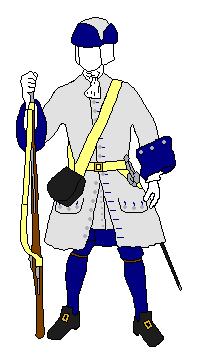
1698-1710 |
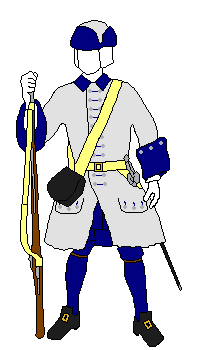
1710-1718 |
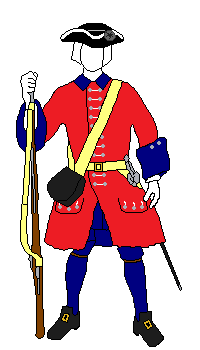
1718-1727 |
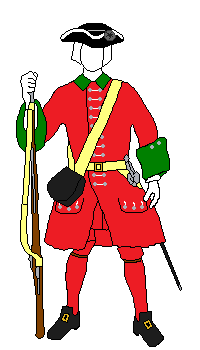
Second Smaalenske |
|
New
uniforms were issued in 1698 according to Skjold Petersen. According
to a regulation from 1697, these were to consist of grey coats with
white buttons and blue lining, breeches, stockings and caps. Until
1708, the officers had blue coats with white lining and cuffs. |
According
to Höglund, new uniforms were issued in 1710. According to a
description from 1713, these consisted of a white (light grey) coat
with blue cuffs, lining, breeches and stockings. Skjold Petersen
mentions that the vest was also blue. |
New
uniform issued in September 1718. According to the 1717 regulation, the
coat was to be red with dark blue facings, lining, breeches and
stockings. The buttons on the issued uniform were white and the
buttonholes may also have been white. |
At an
unknown time during the ten-year period after the partition in 1718,
the Second (West) Smaalenske Regiment received uniforms with dark
green as its regimental colour. Both regiments also received red
stockings and breeches. |
Höglund has the same type of conflicting information about the
Smaalenske regiments as for Akershusiske. According to him, East
Smaalenske Regiment had a yellow edge on its blue cuffs in 1718 and a
brown collar in 1720. The uniform of West Smaalenske Regiment had
yellow cuffs with a black edge in 1718 and a green collar in 1720. The
information about the collars from 1720 seems to come from Otto Vaupell
who is not a reliable source.
Worgewits made uniform drawings for both Smaalenske regiments in 1728
and these are shown further down the page.
|
|
Oplandske
Regiment
|
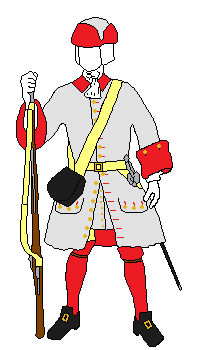
1675 |
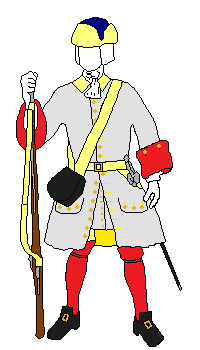
1676? |
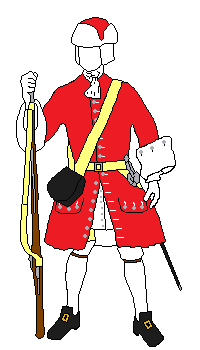
1685 |
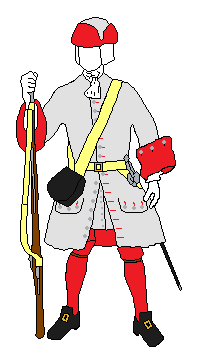
1688-1710 |
|
Red coat with white lining. |
An unreliable source states: grey coat with red cuffs, leather
collar, yellow trimming and yellow buttons, as well as leather
breeches with buttons in the outer seams and leather cap with a dark
blue top. |
Red coat
with white lining. |
1688
Light grey coat with red cuffs and lining.
1695 Grey coat with red lining
1697 A uniform regulation establishes that the uniform shall
consist of grey coats with red lining and red breeches, stockings
and karpuses (karpuses of cloth that could be pulled down over the
ears). The buttons were to be white.
1698 According to Skjold Petersen, new uniforms were issued
this year.
1702 White (light grey) coat with red lining, breeches and
stockings.
1709 Had good swords but useless shoes. |
|
Described in 1667 as "the yellow regiment".
For the Oplandske regiments too, Höglund deviates from Aagaard and
Schorr regarding the appearance of the later uniforms' cuffs and
collars. According to him, East Oplandske had a light green edge on
its steel grey cuffs in 1718 and a light grey collar in 1720. The
only uniform detail he mentions for West Oplandske is a red coat
with a light blue collar in 1720. |
|
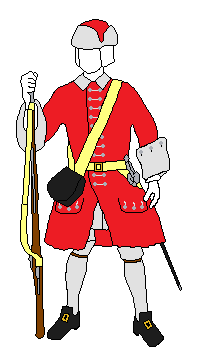
1710-1718 |
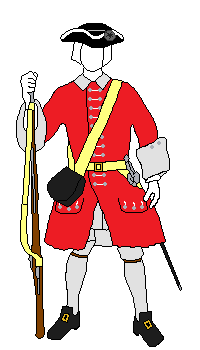
1718-1727 |
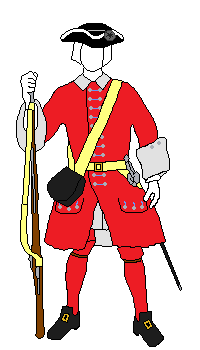
1727 |
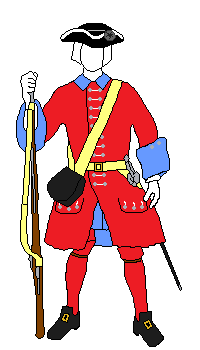
1727 |
|
According
to Höglund, they were issued new uniforms in 1710. According to
Schorr, the uniforms in 1713 consisted of red coats, red lining that
had been "purchased earlier" and a second colour on cuffs and
buttonholes (grey blue). Aagard also mentions red coats in 1713,
while Skjold Petersen states light grey coats for this year (and
everything else red). According to Schor, new red coats with steel
grey facings were issued in 1715. |
A uniform
regulation from 1717 states that the coat should be red with steel
grey cuffs, lining, breeches and stockings as well as white buttons
and buttonholes. The uniform is issued in September 1718.
Six
companies stationed in Trondheim during the 1718 campaign had white
(light grey) coats with red cuffs. |
East (1st) Oplandske |
West (2nd) Oplandske |
|
When the
regiment was split in 1718, both halves received the same uniform
according to Aagaard, but at an unknown time during the following
ten-year period, West Oplandske regiment received light blue as its
regimental colour (Skjold Petersen states, however, that it was
already introduced in 1718). East Oplandske kept the steel grey
(grey blue) colour of the covers, but the colour of the buttonholes
was changed to blue (remained white according to Skjold Petersen).
Both regiments also received red stockings and breeches. According
to Skjold Petersen, East Oplandske had red leg clothes 1713-1761
(but he states steel grey in parentheses for 1727) and steel grey
vest 1718-1727. For West Oplandske he states that both vest and leg
clothes were red 1718-1761 but in parentheses light blue in for
1727. |
|
|
Vesterlenske
Regiment
|
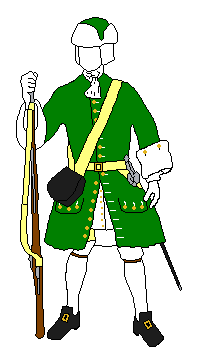
1685 |
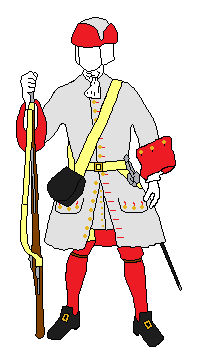
1687 |
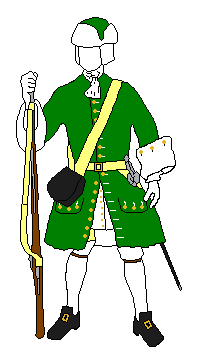
1694 |
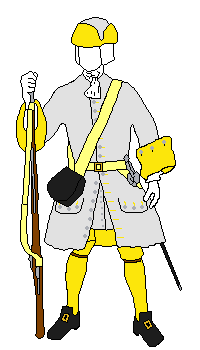
1695-1710 |
|
Green coat
with white lining. |
According to Aagaard: steel green coat
with red cuffs and lining. Also said to have had a green coat with
yellow buttons and white stockings.
According to Skjold Petersen: steel grey coat with red cuffs
and lining. |
Green coat
with white lining. |
1695
The uniform is changed to a grey coat with yellow lining according
to a decision from 1689.
1697 A uniform regulation establishes that the uniform shall
consist of grey coats with yellow lining and yellow breeches,
stockings and caps. The buttons should be white. According to
Höglund, the yellow colour could possibly have been feuille morte.
1700. Grey-white coat, karpus with yellow lining and yellow
breeches. |
|
Grey coat and red karpus in 1658.
In 1709 the regiment received new flintlock muskets without
bayonets. |
|
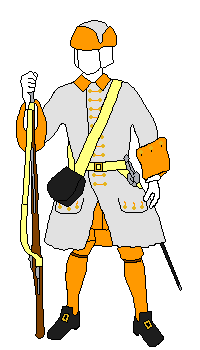
1710-1718 |
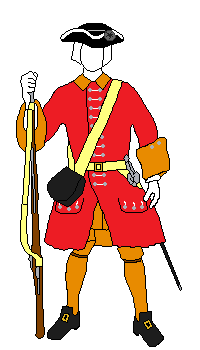
1718-1727 |
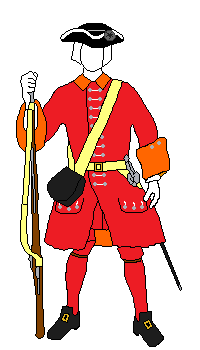
1727 |
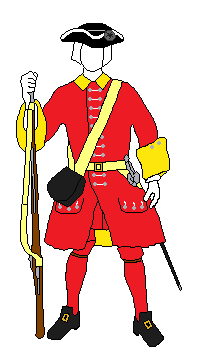
1727 |
|
1702
It was decided that the regiment would receive brass buttons
instead of cloth buttons the next time it received new uniforms.
1710 New uniforms were issued at the New Year. According to
Höglund, these consisted of light grey coats with “fire yellow” (=
orange) cuffs.
1712-13 New uniforms which included yellow breeches were
issued.
1713 White (light grey) uniform with yellow cuffs, lining,
breeches and stockings. Skjold Petersen states that the vest was
also yellow. |
A uniform
regulation from 1717 states that the coat should be red with feuille
morte (yellow-brown) cuffs, lining, breeches and stockings, as well
as white buttons and buttonholes. The new uniform was issued in
November 1718. Skjold Petersen states that the leg clothes were red
from 1718. |
East (1st) Vesterlenske |
West (2nd) Vesterlenske |
|
At an
unknown time during the following ten-year period, the uniforms were
changed so that the eastern regiment's colour became aurora
according to Skjold Petersen, while Aagaard describes it as "brown
yellow (red yellow/aurora)". The western regiment received light
yellow (lemon yellow) as the regimental colour, which Skjold
Petersen states that it already had in 1718. Both regiments also
received red stockings and breeches, and possibly blue buttonholes
according to Aagaard. Skjold Petersen states that leg clothes and
vests were already red from 1718, except that the eastern regiment
had feuille morte vests until 1727. Höglund also states that, unlike
the others, the eastern regiment had yellow cuffs with a light green
edge in 1718 and a brown collar in 1720. The western the regiment
had a yellow collar in 1720. |
|
|
Bergenhusiske
Regiment
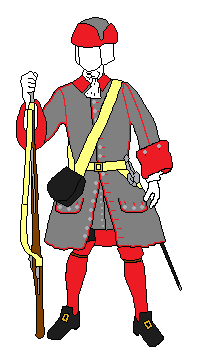 |
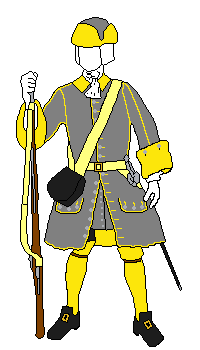 |
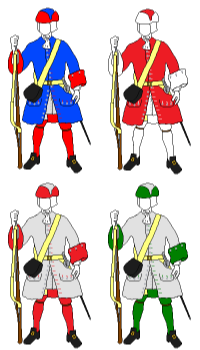
1680-1698 |
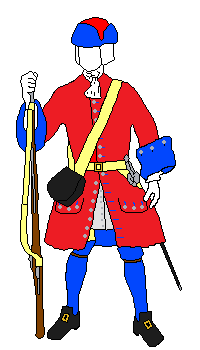
1687-1710 |
|
Scanian War |
|
1660
Bright red collar and lining.
1676 Dark grey coat and black trousers.
1677 Dark grey coat with red lining and red inlays in the
seams. Also received dark grey coats with yellow cuffs and edges.
1678 Red coat with yellow lining and yellow edges
(officers?).
1679 Dark grey and light grey coats of cloth. White buttons.
The non-commissioned officers and musicians received red coats of
cloth. |
1680
The colonel’s company (Indre Sogn) received blue coats.
1685 Red coats with white lining (or white coats with red
lining).
1687 White (light grey) coats with red lining and red coats
with blue lining.
1689 Light grey coat.
1697 Light grey coat with green lining.
1698 Green cuffs. |
1687
Red coat with blue cuffs, blue baize lining, and karpus. Also
received white (light grey) coats with red lining.
1710 The regiment complained that they had several red coats
that were 23 years old. |
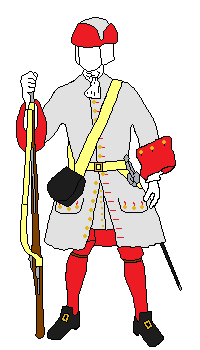
1698-1713 |
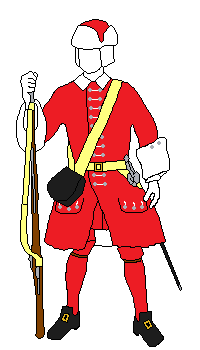
1713-1715 |
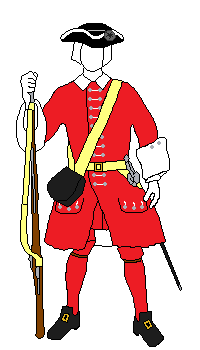
1718-1732 |
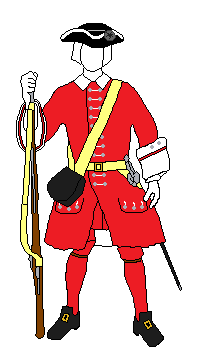
First Bergenhusiske |
|
1698 New
uniforms issued this year according to Skjold Petersen.
1709 White (light grey) coats with red lining and cuffs and brass
buttons. Some companies had red coats with blue facings.
1710 New uniforms issued this year according to Höglund.
1711 Ordered red coats, vests, breeches and stockings with white
cuffs and lining and brass buttons. However, this uniform was
probably not issued. |
1713 New
red uniform with white lining is issued. The old grey-white coats
are to be re-sewn into vests. They were allowed to continue wearing
a karpus instead of a hat.
1715 Red coat, vests, breeches and stockings. Lining and cuffs were
white. Höglund also mentions white collar.
1717 Red coat with white lining cuffs, breeches and stockings. |
A uniform
regulation from 1717 states that the coat should be red with white
cuffs, lining, buttons and buttonholes. Breeches and stockings would
again be red. The uniform was first issued in December 1718 when the
regiment was split and according to Aagaard and Schorr the two
regiments received the same uniform. |
According
to Aagaard, at an unknown time during the ten years that followed
the partition in 1718, First (North) Bergenhusiske received a red stripe on
its cuffs. Possibly, the button colour was also changed to yellow
and the buttonholes to blue.
According to Skjold Petersen, they got the red stripe as early as
1718 and the vest was then white but became red not later than 1727.
According to Höglund, North Bergenhusiske had a blue edge on its
cuffs in 1718. |
|
|
First Trondhjemske Regiment
(also called Old Trondhjemske, North Trondhjemske
and 1. Trondhjemske)
The
original Trondhjemske regiment was raised in 1628 and split into two
regiments in 1657 (old and new). Both were dissolved in 1658 because of
the Peace of Roskilde which transferred the County of Trondheim to
Sweden. But already in December of the same year, the county was
reconquered, and the regiment was re-established. It was temporarily
divided again during the Scanian War 1677-1679 and then permanently
divided in 1710.
|
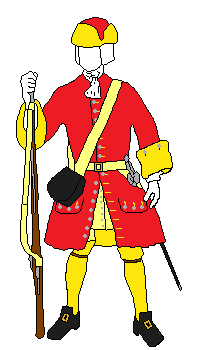
1677 |
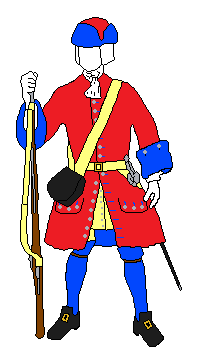
1679-1688 |
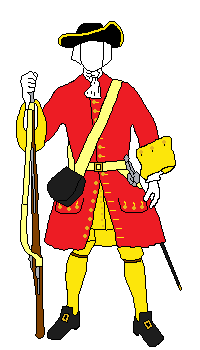
1688-1698 |
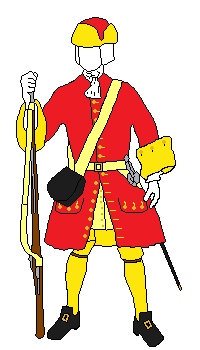
1698-1710 |
|
Red coat
with yellow lining.
In
1659, the Colonel’s company had been issued 104 blue coats and
karpuses and 103 red coats and karpuses. |
1679
Red coat and karpus. The non-commissioned officers had light and
dark grey coats. The musicians had dark grey coat and red karpus.
1685 Red coat with blue lining.
Skjold
Petersen states yellow lining "1679-" but notes that it was blue
according to accounts from Tøjhuset. He also states that the cuffs
were blue and the buttons were white in 1679. |
A decision
was made in 1687 that the regiment would have a red coat with yellow
cuffs and breeches and a black hat (yellow vest according to Skjold
Petersen). This uniform was issued in 1688-90 (according to Aagard).
Skjold
Petersen states that the coat was grey in 1689. A temporary uniform
while waiting for the new uniform? |
New
uniforms issued in 1698 (according to Skjold Petersen). It was
decided in 1701 that the coat would be blue with red lining, but in
1708 the regiment still had red coats with yellow cuffs and linings
and brass buttons.
According
to Höglund, the uniforms were described in 1709 as worn out and 23
years old. |
|
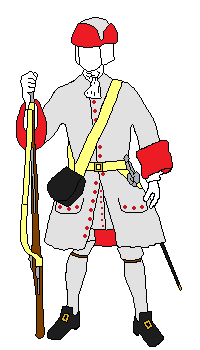
Reserve companies 1703 |
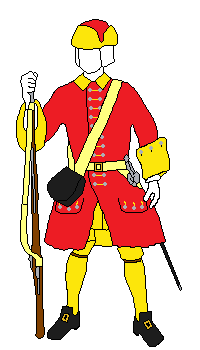
1710-1718 |
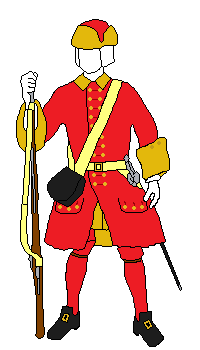
1718- |
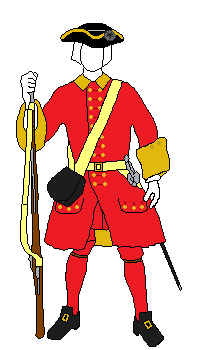
-1732 |
|
Grey coats
with red cuffs and buttons and karpuses with red lining.
Their
uniform is said to have been so worn in 1709 that it could not be
used in the field. |
New
uniform issued in 1710 in connection with the partition (according
to Höglund). Both regiments were stated in 1713 to have red uniforms
with yellow small clothes and that they should keep these. In 1715
it was decided that they were to be receive red coats with blue
cuffs and lining the following year, but that uniform was not
issued. In 1716 the uniform was stated to consist of red coat with
yellow lining, cuffs, breeches and stockings ("blue" was crossed out
and replaced with "yellow" in the document). |
New
uniform issued in late 1718. According to the 1717 regulation, the
coat was to be red with yellow cuffs, lining, breeches and
stockings. The privates were to have karpuses while the NCOs and
musicians would have hats.
According
to Skjold Petersen, it was red leg clothes that was issued in 1718.
The vest was yellow, but was replaced with a red one before the next
set of uniforms were issued in 1732. |
Zimmer's
plate from 1730 depicts the uniform as a red coat with dark yellow
cuffs. The buttons were yellow with red or blue buttonholes. The
vest was red from no later than 1727.
I haven't
seen the plate myself, so I don't know what is meant by "dark
yellow", but Aagard describes lemon yellow as "light yellow". I have
also assumed that the regiment had hats at this time. |
Höglund has different information for the uniform that was issued in
1718. In that year, according to him, the First Trondhjemske had light
green cuffs with a yellow edge. The collar is stated in 1720 to have
been chamois coloured, which is a statement he seems to have taken from
Vaupell, who is an unreliable source.
Höglund also mentions that the Trondhjemske regiment received new
uniforms in 1710, which consisted of 1,700 coats, 2,600 trousers, 1,700
breeches, 2,700 pairs of shoes, 500 shirts, 600 neckcloths and 600 pairs
of undyed socks. Before the partition, the regiment had a strength of
3,000 men, of which a third was made up of the reserve companies.
|
|
Second Trondhjemske Regiment
Formed in 1710 by partitioning the Trondhjemske regiment, but it had two
temporary predecessors that had been formed in the same way (1657-1658
and 1677-1679). These regiments were also called New Trondhjemske,
South Trondhjemske and 2. Trondhjemske.
|
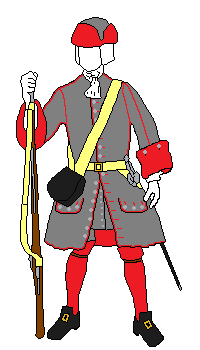
1678 |

1710-1716 |
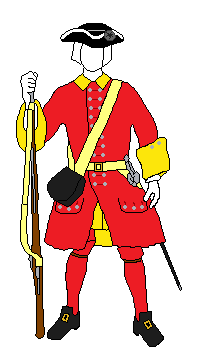
1716-1718 |
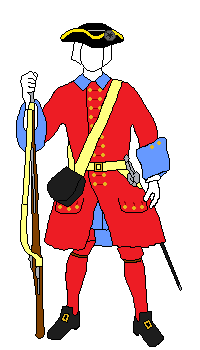
1718-1727 |
|
Dark grey
coat with red cuffs, lining and edges. In 1679, two companies
received red coats with yellow lining and edges in yellow (according
to Aagard).
According
to Skjold Petersen, the regiment had a red coat and yellow cuffs in
1677-1680. |
New
uniforms issued in 1710 in connection with the partition (according
to Höglund). Both regiments were stated in 1713 to have red uniforms
with yellow small clothes and that they should keep these. |
Was issued
hats in 1716 and according to Schorr also red breeches and
stockings. According to a decision from 1715, the uniform in was to
consist of a red coat with yellow lining, yellow cuffs and brass
buttons. But according to Skjold Petersen, the buttons were white
and the leg clothes and vest were yellow (or grey). |
New
uniforms were issued at the end of 1718 which, according to the
regulation of 1717, were to consist of a red coat with light blue
cuffs and lining, brass buttons and red breeches and stockings. The
buttonholes were red or blue. The vest was light blue but became red
not later than 1727. Skjold Petersen states yellow buttons in 1718
and 1730 but white buttons in 1727 even though he also states that
the coat was not replaced between 1718 and 1732. |
|
|
Other Infantry Regiments

Kragh's Regiment
1710 |

Røros Volonteer Corps
1710-1720 |
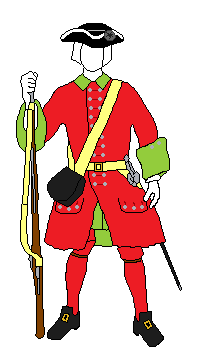
Third Trondhjemske
1719-1727 |
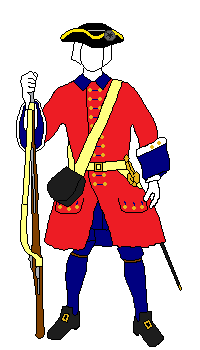
Poulsen's regiment
1723-1730 |
|
Recruited
in 1710 from ex-soldiers who had completed their ten years' service
with the national regiments. But it was disbanded at the end of 1710
due to cost savings and the high average age of the soldiers. |
400 men
in three companies recruited from the miners in Røros who were exempt from conscription. |
Red coat
with light green lining and cuffs as well as white buttons and red
or blue buttonholes. Light green vest and red leg clothes. The vest
became red no later than 1727. Höglund has information that the
cuffs were violet with yellow and black stripes in 1718. |
Red coat
with blue lining and blue cuffs with a white stripe at the top. Blue
vest and leg clothes.
In 1727
the shade was dark blue and the buttons yellow with dark blue
buttonholes. In 1730 the shade was light blue with white buttons and
buttonholes. |
The third (middle) Trondhjemske regiment was formed in January 1719 by
men from the other Trondhjemske regiments.
"Poulsen's enlisted dragoon regiment on foot" was formed on 26
March 1719 from the enlisted companies of the two Søndenfjeldske dragoon
regiments. It retained the uniforms of its parent regiments until 1723
(all red coats, 400 men with blue cuffs and 200 men with white cuffs).
|
|
Ski Corps
|
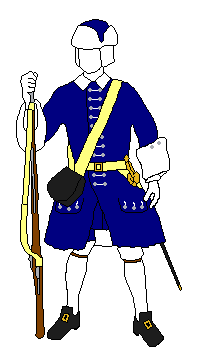
Skiers and Fyrrør
1711-1717 |
|
Blue coat with white lining, white cuffs and white buttons. Skjold
Petersen states on page 524 that their breeches were made of linen and
that the stockings were white. On page 624 he states that the leg clothes
were blue, possibly the vest too.
|
|
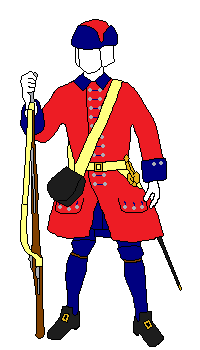
Ski Corps
1717-1721 |
|
Red coat with dark blue lining, cuffs and leg clothes. Possibly also dark
blue vest. In 1720-1721 one Nordenfjeldske company had blue cuffs and the
other had yellow cuffs. |
Already during the Scanian War, three temporary ski
companies were established and then disbanded at the end of the war.
But these were not an independent unit, they were part of Oplandske
Regiment and had their uniform (light gray coat with red lining and
cuffs).
At the outbreak of war in 1709, a decision was made to reinstate skiers
by raising two such companies, but recruitment to them was not
successful. In the winter of 1710-1711, another attempt was made and
this time they succeeded in setting up a ski company in
Kongsvinger and a "fyrrør" company in Fredriksten. Fyrrør was
actually the name for a type of musket but now
probably had the meaning "sharpshooters". It is unclear whether there
was actually any practical difference between these companies that wore
the same uniform. Both were used as reconnaissance units and had the
same pay as grenadiers. However, the Fyrrør Company was transferred to
northern Germany in 1713 where they were later incorporated into the
Grenadier Corps.
According to Karsten Skjold Petersen, the Ski Corps were
organised into two companies in 1717, one Søndenfjeldske
and one Nordenfjeldske. However, later in the book he mentions two
Nordenfjeldske companies. According to Daniel Schorr, two
Nordenfjeldskle companies were established in 1718 in addition to the
original Søndenfjeldske company. All companies were disbanded in 1721.
The choice to have a dark blue lining on the red coat in 1717 was
intended to facilitate the scouting missions on enemy territory. By turning the coat inside out, they could appear as if they
were Swedes. For this purpose, the coat was also shorter as well as
wider and provided with small cuffs. |
|
Land Dragoons and Garrison Companies
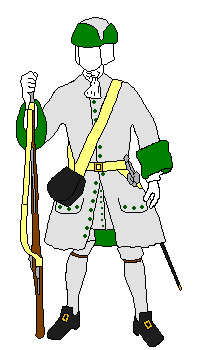
Søndenfjeldske
land dragoons |

Nordenfjeldske
land dragoons |

Brun's Regiment
(3. Akershusiske) |
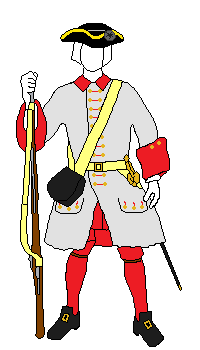
Garrison company
1718 |
|
According to Schorr, they had grey
vadmal coats. The Søndenfjeldske companies may have had green facings, while the
Nordenfjeldsk companies
may have had red facings. Höglund has an unspecified description about
land dragoons with grey uniforms and red caps. |
Formed by land dragoons in southern Norway and existed 1718-1721. |
Trondheim's company had light grey coats with red facings during the
campaign of 1718. The uniforms of Bergen's company are completely
unknown, but these companies may have had the same uniforms. Compare the
Danish free companies. |
The land dragoons were a form of home guard that was created in 1673
but ultimately had its origins in the old peasant levies which mustered
all able-bodied men. As the peasant levies had very little
military value, it was reformed in 1673 so that independent companies
were formed consisting only of selected men from the civilian population. The
company districts matched the companies of the national regiments so
that the same "legder" recruited both soldiers to the national regiments and
to the land dragoon companies. During its existence, the land
dragoons were known by several different names: the selected ("de utvalgte"), the enrolled
("de inrullerte"), every-other-man ("annenhver man") and armed peasants ("væbnede bønder").
But during the Great Northern War, land dragoons became the dominant name,
despite the fact that they were not mounted soldiers.
In 1711, the land dragoons consisted of 20 Søndenfjeldske (= "south of the mountains")
companies with a total of 3,576 men, and 9 Nordenfjeldske (= "north of the mountains")
companies with 2,131 men. However, their military value was limited and they were
mainly used for garrisons duty in the fortresses and guarding the long frontier.
Thus freeing the regular troops for more important tasks. When the national regiments
were divided in 1718, the men from the land dragoon companies were used to fill
the ranks of the now expanded army. The remainder formed a 1,200 strong
regiment in southern Norway under the command of Hans Jakob Brun. This
regiment was also called the "3. Akershusiske Regiment" but it was
disbanded already in 1721. |
|
First Søndenfjeldske Dragoon Regiment
|
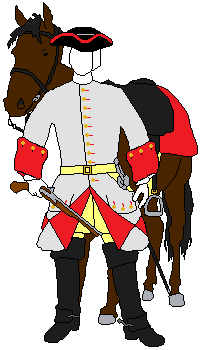
Before 1714 |
Raised as a cavalry regiment in 1661 and
reformed in 1701 as a six-company strong dragoon regiment. Consisted
solely of national companies except for the years 1716-1719 when it
had two enlisted companies (and eight national).
Got the name in the heading in 1729. Before that
it was named after the regimental commanders below.
1661
1666
1670
1676
1682
1696
1710
1723
1725 |
Johan Brockenhuus
Joakim Kørber
Matias Recke
Jakob Bülow
Johan Daniel Richelieu
Jens Maltesen Sehested
Ulrik Kristian Kruse
Henrik Bernhard Schaffalitzky de Muckadel
Johan Fredrik Brockenhuus |
|
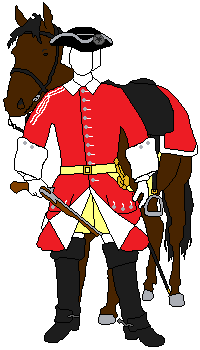
Not later than 1717 |
1677
Dark grey coats and breeches were issued as well as dragoon karpuses.
1687 Light grey coats with red lining and trimming.
1701 The regiment would continue to wear light grey coats with
red lining after the reorganisation to dragoons.
1703 New uniforms issued.
Sometime during the period 1704-1710 the officers are noted to
have had steel grey
cloaks and coats with crimson lining. The coat had buttonholes of silk and
camel hair as well as gilded buttons. The vest was of red cloth with yellow
thread along the buttonholes and gilded buttons. Breeches of red cloth and fine
knitted stockings (white 1710). Hat with thin lace (after 1710 described
as yellow). NCOs had mainly the same uniform. Drummers and privates had
somewhat shorter coats as well as vest, breeches and gloves of leather.
1710-1714 Same uniform as above. |
Autumn 1709 Cuirasses were issued.
1712 It was decided that the saddle cloth and pistol covers should
be red with decorations in the regimental colour (the King's cypher).
1714 A decision was taken 16 March to change to red coats. This
was done not later than in 1717 and the colour on the lining and facings
was then white.
1717 According to a regulation the dragoons should probably have breeches and
stockings in the regimental colour and a leather vest.
Spring 1718 New uniforms which had been ordered the year before
were issued.
1730 A plate painted by Zimmer shows the regiment with a red coat
with lining, facings, collar and shoulder cords in white. |
In contrast to Aagaard, Höglund states that the regiment already in 1709 had red coats with facings and lining in
white. He also mentions that the red coat in 1720 had a white collar.
And informs that in 1718 the horses were mainly of small stature and the
colours were "mostly chestnut, yellow, grey, very rarely brown or
black".
|
|
Second Søndenfjeldske Dragoon Regiment
The regiment traces its origins to two independent
dragoon companies that were raised in 1670. When the Scanian War broke
out in 1675, the number of companies was increased to six, which were
joined into a regiment commanded by Ulrik Fredrik Gyldenløve. This
regiment was named "Livregiment dragoons" but from 1683 was named after
its regimental commanders until 1729 it received the name given in the
heading above.
1675
1683
1698
1711 |
Ulrik Fredrik Gyldenløve
Kristian Fredrik Marschalk
Frans Vilhelm Folckersam
Johan Øttken |
The
regiment consisted before 1701 of 6 national and 4 enlisted companies.
After that it had 4 national and 3 enlisted. 1716-1719 it consisted of 6
national and 5 enlisted companies. After 1719 it consisted of only 8
national companies.
|
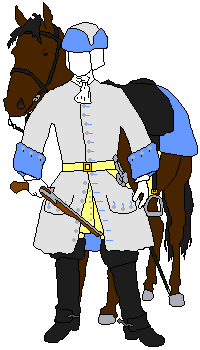
1677 |
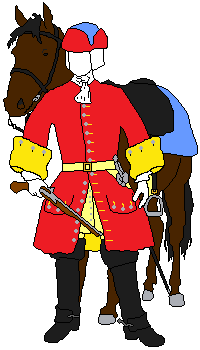
1683 (enlisted companies) |
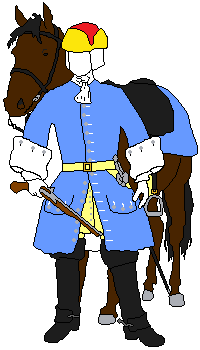
1683-1688 |
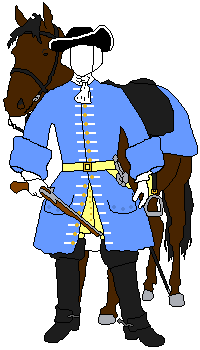
1698 |
|
Light grey coat with light blue trimming. |
The four enlisted companies received cloth and baize to manufacture
red coats with yellow lining and pewter buttons. The enlisted
dragoons karpuses probably came in two variants, both blue but with
facings and lining in red or yellow (alternatively they had the same
karpus but with lining and facings in different colours). |
1683 The two national Søndenfjeldske reserve received blue cloth
coats with pewter buttons and red cloth karpuses with lining and
facings of yellow baize.
1685 Blue coat with
white lining.
1688 The regiment was to have karpuses. |
Granted money for new uniforms. The
coat was to be of blue cloth with white baize lining and have 18
brass buttons. In addition, they would have four dozen camel hair
laces (for the buttonholes?) and lace at the back. Since white
cloth is not mentioned, the cuffs were probably blue. The
overcoat was to be of white cloth with blue lining and have two
dozen brass buttons. The hat was to have white camel hair lace. |
|
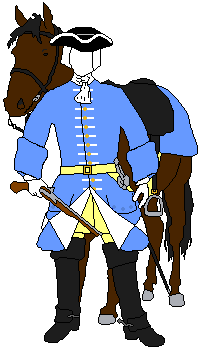
1701 |
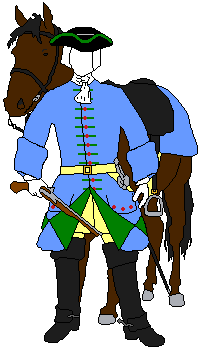
1701 |
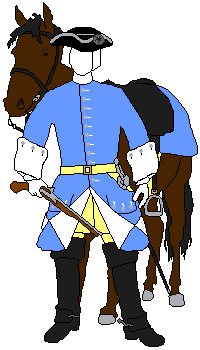
1710 |
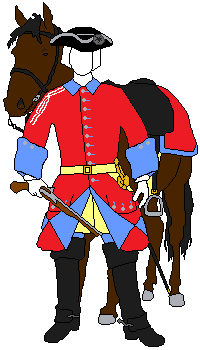
Not later than 1717 |
|
National companies
Blue coats with lining and trimming in white, and the enlisted
companies had blue coats with lining and trimming in green. |
Enlisted companies
Blue coats with lining and trimming
in green. All enlisted dragoon companies in Norway were to have red
buttons with lace. |
Received new uniforms in 1703 (according to Aagard) which
in 1709 (according to Höglund) and 1708-1713 (according to Skjold
Petersen) consisted of blue coats with white lining and white cuffs.
Aagard states that the buttons were silver-plated in 1707 and that
hats with lace and cockades were introduced in 1710. |
1714 A decision was taken 16 March to change to red coats with
lining and facings in light blue. This was done not later than in 1717 (facings
and lining were then just described as blue).
1717 According to a regulation the dragoons should probably have breeches and
stockings in the regimental colour and a leather vest.
Spring 1718 New uniforms that had been ordered the year before
were issued. Silver lace on the hat according to Höglund, who also
mentions that the horse quality was as bad as in the First
Sunnanfjeldske regiment.
1730 A plate painted by Zimmer shows the regiment with a red coat
with lining, facings and collar in dark blue and shoulder cords in
white. |
|
Skjold Petersen states that the regiment had a
steel grey coat with red facings in 1707. The source of that information
is a royal resolution from 8 January 1707. According to him, the blue
coat with white lining was worn in 1698 and 1708-1713. However, Aagard
states that the blue uniform with white lining was worn until the
introduction of the red coat with blue lining. He refers to an account
of the regiment's condition from 1712 which states that it had received
new uniforms in 1703.
Cuirasses were issued in the autumn of 1709, but already in 1712 these
were handed over to the nearest fortress.
On 13
February 1712, the decision was made that the shabraques and pistol
covers should be red with decorations in the regimental colour, the
shabraque would have the king's crowned name cipher. 700 new coats
(re-sewn cassocks) were issued this year along with 15 drums and 300
shabraques. |
|
|
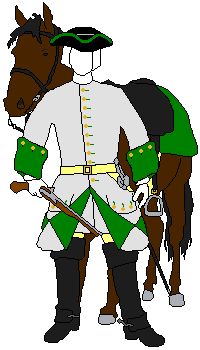
Before 1714
|
|
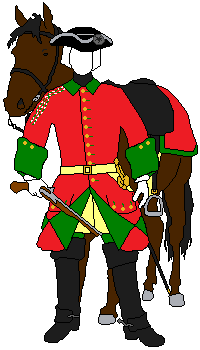
Not later than 1717
|
Nordenfjeldske
Dragoon Regiment
Formed in 1701 as a dragoon corps consisting of
four national and one enlisted Nordenfjeldske company that was
transferred from the other dragoon regiments. Also called the Trondheim
Dragoon Corps. Expanded in 1719 to a full dragoon regiment consisting of
eight national companies.
1702
1717
1718 |
Povl Halcke
Nik. Kristian Reichwein
Peter Motzfeldt |
1701 When the corps was created from
the northern companies of the two preceding regiments it retained their
old uniforms in the beginning. 200 uniforms consisting of light grey
cloth and blue baize were however ordered from a supplier in Bergen. All
enlisted dragoon companies were to have red buttons with lace.
1702 It is stated that the corps was to have light grey coats
with green trimming.
1703 New uniforms were issued.
1710 Cuirasses were issued.
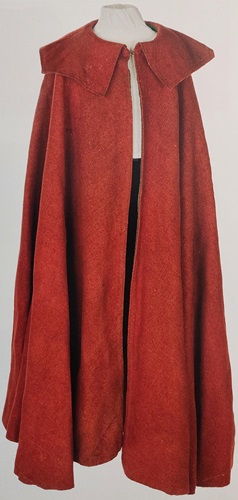 1712 It was decided (13 February) that saddle cloths and pistol
covers were to be red with decorations in the regimental colour, the
saddle cloths should have the King's cypher. 15 drums were also issued
this year 1712 It was decided (13 February) that saddle cloths and pistol
covers were to be red with decorations in the regimental colour, the
saddle cloths should have the King's cypher. 15 drums were also issued
this year
1714 A decision was taken 16 March to change to red coats, which
was done not later than 1717. The green regimental colour was retained.
1716 According to the accounts the corps had hats with
embellishments, coats of coarse wool with facings and collar of green
baize as well as leather breaches and "half boots".
1717
According to a regulation the dragoons should probably have breeches and
stockings in the regimental colour and a leather vest.
1719 A disbanded enlisted company returns their uniforms which
consisted of red coats with green lining and brass buttons and red
cloaks.
1730 A plate painted by Zimmer depicts the regiment with a red
coat with lining, facings and collar in dark green as well as
cords in green and white on the right shoulder.
The photo to the right
depicts a cloak from the 18th century which is kept at Forsvarsmuseet in Oslo. It has the same appearance as a cloak that is
kept in Trondheim (se photo below) and very possible was one of the cloaks belonging
to Nordenfjeldske Regiment which were returned to the armoury in 1719.
Note that the falling collar completely cover the shoulders.
Aagard also have a report
from 1733 showing what equipment one of the companies had (the years in
parenthesis notes when they were issued):
NCOs: hat with
silver lace (1732), black neckcloth (1733), gloves (1729), cloak with
brass hooks (1716), red coat with facings of blue plush as well as
silver buttons and buttonholes (1727), leather breaches (1727).
Drummers: hat with lace and cockade (1725), black neckcloth
(1733), gloves (1725), cloak with brass hooks (1716), red coat with lace
(1729), blue vest (1727), leather breaches (1727).
Dragoons: hat with lace and cockade (1725), black neckcloth
(1733), gloves (1725), cloak with brass hooks (1721), red coat with
facings of blue plush and shoulder cords (1725), blue cloth vest (1727),
leather breaches (1727).
Curiously the facings and
vests are described as blue in this report even though the other sources
states that the regimental colour was green at this time. It is however
common for green colours to become blue when they fade.
Lars-Eric Höglund states
that the horses were small in this regiment too and in 1720 its soldiers
had hats with silver lace and red coats with grey collar, facings and
lining.
|
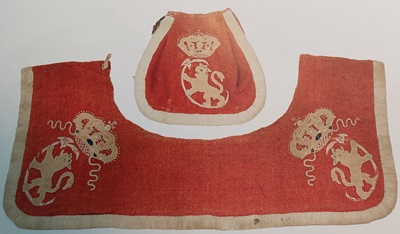 |
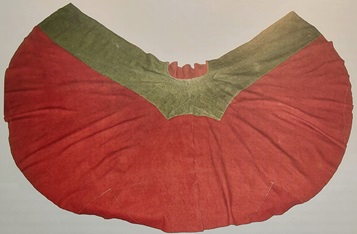 |
|
Shabraque
and pistol cover for the Third Søndenfjeldske Regiment, which was
raised in 1750. The edges are paille yellow, which was the
distinctive colour of this regiment. The symbol here is the Norwegian
coat of arms, but during the Great Northern War all regiments had instead
Frederik IV's monogram as decoration. |
The
inside of a cloak with the same appearance as the one further up.
This cloak is kept in the Rustkammeret in Trondheim and is partially
lined with green. It is very possible that this cloak is one of those
that Nordenfjeldske Regiment returned in 1719. |
|
|
Worgewitz Uniform Plates from 1728
|
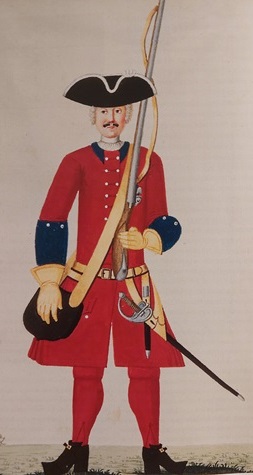
First Smaalenske |
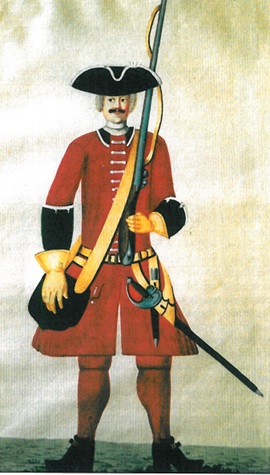
Second Smaalenske |
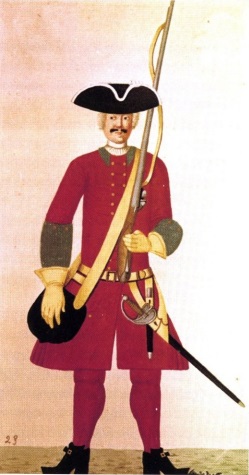
"South Trondhjemske" |
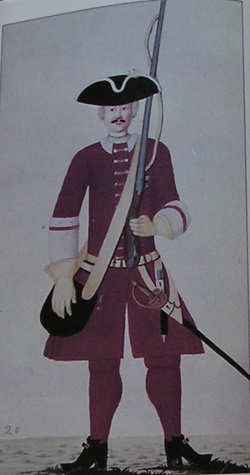
First Bergenhusiske |
|
The plate is taken from Karsten Skjold Petersen's book "Kongens klæder"
from 2014. The uniform colours in the drawing correspond to the sources.
Skjold Petersen also notes that Worgewitz depicts all infantrymen with
moustaches but that this was later reserved for grenadiers. |
The plate is taken from Erik C. Aagaard's article "Uniformene til den
norske hærs linjeinfanteri" from 2002. The uniform is depicted with a
white edge along the dark green cuffs and collar. In another plate from
1730 drawn by Zimmer, however, there are no white edges. Since Zimmer's
plates generally agree better with other sources than Worgewitz does, it
can be considered probable that the regiment did not have white edges. |
The plate is taken from Knut Erik Strøm's book "Hærens uniformer i
dansketiden – et billedhefte med samtidige avbildninger" from 2002.
However, the southern regiment (1. Trondhjemske) had a light blue
regimental colour, while it was the middle regiment (3. Trondhjemske)
that had a light green colour. I don't know if it is Worgewitz or Strøm
who has made a mistake or if it is the colour reproduction in the
picture that is bad. |
The plate is taken from Erik C. Aagard's book "Den norske hærs uniformer
i dansketiden – et billedhefte" from 1992. The photo is dark, but the
uniform colours correspond to the sources. An interesting detail is that
the sword hilt is brass, which is what the swords would be according to
m/1710. But in Worgewitz's plates, it is otherwise only enlisted
regiments that have brass, while the national regiments have iron hilts.
This may be because they were issued older equipment. |
There are also Worgewitz plates on artillery page. |
|
References
Aagaard, Erik C.
Den norske hærs uniformer i dansketiden: et billedhefte. Oslo 1992)
Aagaard, Erik C. Uniformene til den norske hærs linjeinfanteri – Del 1 Dansketiden
(article in NVSÅ 2000/01). Oslo (2002)
Aagaard, Erik C. Uniformene til den norske hærs kavaleri – Del I Dansketiden
(article in NVSÅ 2007). Oslo (2007)
Höglund, Lars-Eric – Sallnäs, Åke. Stora nordiska kriget 1700-1721, II.
Karlstad (2003)
Schorr, Daniel. Notes on the Norwegian Army 1700-1720. (2008) *
Skjold Petersen, Karsten. Kongens klæder. Copenhagen. (2014)
Strøm, Knut Erik. Hærens uniformer i dansketiden – et billedhefte med
samtidige avbildninger. Oslo (2002)
Vaupell, Otto. Den danske hærs historie til nutiden og den norske hærs
historie indtil 1814. Copenhagen (1872-1876)
* = article published in 2008 on the now defunct website
www.northernwars.com
The information about Norwegian uniforms
presented below comes mainly from articles written by Erik C. Aagaard, with
complementary information from Karsten Skjold Petersen, Daniel Schorr and
Lars-Eric Höglund. However, the information from these persons is to
a certain extent contradictory, specifically on the new uniforms from 1717/18.
According to Aagaard the partitioned regiments were issued identical
uniforms and it was not until the 1720s that the new regiments got
distinctive uniforms. Höglund on the other hand mentions distinctive
regimental cuff colours in 1718 and collar colours in 1720. These colours
not only contradict Aagaard but also themselves since the cuffs and
collars are given different colours by Höglund. I suspect that Höglund's
information comes from two different sources and that the colour on the
collars in 1720 is taken from the 19th century historian Otto Vaupell (who
is notoriously unreliable). Höglund's information about cuffs in 1718 is
not necessarily in conflict with Aagaard if you consider that the latter
refer to what was written in the regulation from 1717 and that the uniforms
actually issued in 1718 may well have had a different appearance. Daniel Schorr has
also notes about red vests and stockings for some regiments in
1717/18 even though these should have been in the regimental colour
according to Aagaard's
article about the infantry. Aagaard has however in an e-mail to me
acknowledged that Schorr is correct and that he had misread the source when
he wrote his article. |
|

